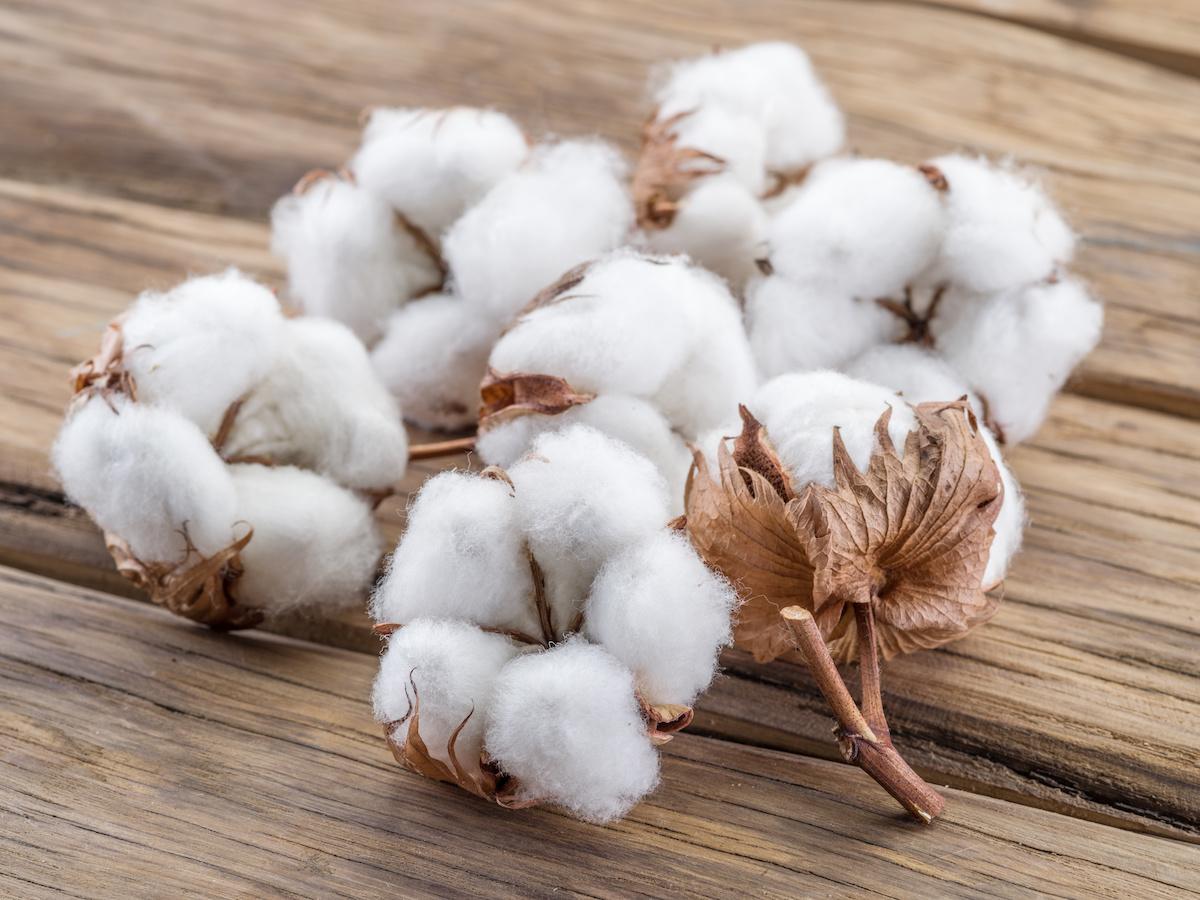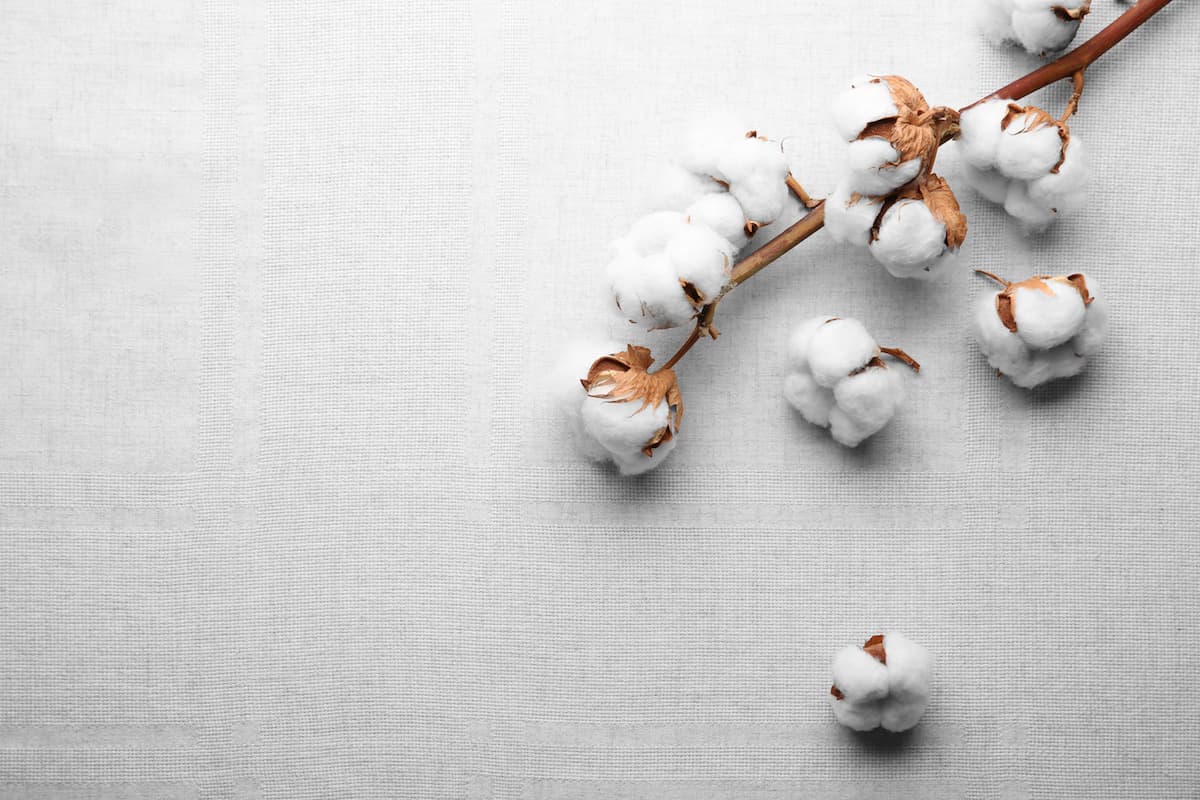Cotton is a staple textile of the fashion industry. Every closet probably houses a large percentage of cotton items, be it plain cotton, dyed cotton, or cotton mix. Cotton is a natural fiber derived from cotton plants whose use dates back to the fifth millennium B.C.

What Is Cotton?
Cotton is a staple fiber, which means it is composed of different, varying lengths of fibers. Cotton is made from the natural fibers of cotton plants, which are from the genus Gossypium.
Cotton is primarily composed of cellulose, an insoluble organic compound crucial to plant structure, and is a soft and fluffy material. The cotton plant needs lots of sun, a long period without frost, and a good amount of rain.
The term “cotton” refers to the part of the cotton plant that grows in the boll—the encasing for the fluffy cotton fibers. Cotton is spun into yarn that is then woven to create a soft, durable fabric.
Where Did Cotton Originate?
The word cotton comes from the Arabic word “quton.” The earliest production of cotton was in India, where the material dates back to the fifth millennium B.C.
The first cotton gin, which is a tool that separates the cotton fluff from the plant seeds, was invented in India in the thirteenth century. The cotton gin made the production of cotton much easier and faster, helping the fiber spread as a widely-used textile.
During the Industrial Revolution, with the invention of new technologies like the spinning jenny, spinning frame, and spinning mule, Britain became one of the leading cotton producers. All of these spinning machines allowed manufacturers to spin cotton at increased rates.
However, it was the American Eli Whitney’s invention of the mechanical cotton gin which led to increased production of the material in the United States and Europe. This new tool, which separated the seeds from the cotton quickly and efficiently using machine power, cut down the hours of manual labor needed to produce a bale of cotton from 600 hours to just 12. Around the same time, America, particularly the Southern states, began producing more high-quality cotton, as the fibers were slightly longer and stronger.
With a few occasional falls in production, such as during the Civil War, the United States is still one of the leading producers of cotton in the world, falling just behind China and India.
Where Does Cotton Grow?
Cotton grows in nearly all tropical and subtropical regions around the world, including the U.S., China, India, Uzbekistan, Pakistan, Brazil, and Turkey.
In the United States, Texas is the largest cotton producer, and the South Plains region in the northern part of the state is the largest contiguous cotton-growing area in the world.
How Is Cotton Processed?
Cotton production is a very involved process, from planting cotton seeds to picking the cotton crop to the processing it in a cotton gin.
- While cotton was picked and separated by hand in the early days, today, most cotton production starts with a cotton picker (which picks the entire plant) or a cotton stripper, with strips the boll off the plant.
- After the cotton is picked, it baled and stored in the fields before it is sent to the gins.
- At the gins, the cotton bales are cleaned and fluffed to separate the material from dirt, seeds, and lint.
- After the cotton has gone through the gins and is completely separated from the seeds, the raw cotton is compressed and stored, ready to ship off to textile mills for further production.
- The cleaned and fluffed cotton is put through a carding machine, which further cleans the material and forms the short fibers into a long untwisted rope that is then ready for spinning and weaving.
4 Different Types of Cotton
There are four different types of cotton, each with its own characteristics.
- 1. Pima cotton. Considered the finest type of cotton in the world, pima cotton’s fibers are extra soft and extra long. The cotton is native to South America and the American Southwest. Pima cotton fabric is very highly-sought after, as it is resistant to fading, tearing, and wrinkling.
- 2. Egyptian cotton. Egyption cotton is very similar to pima cotton. The two are even in the same scientific class: gossypium barbadense. It has the same resistant qualities, but it is grown in the Nile River Valley in Egypt.
- 3. Upland cotton. Upland cotton has very short fibers and makes up about 90% of the world’s total cotton production. The crop is native to and grown in Central America, Mexico, the Caribbean, and southern Florida.
- 4. Organic cotton. Organic cotton is any type of cotton that is grown without chemicals and from plants that are not genetically engineered.

What Are the Characteristics of Cotton?
Cotton has a number of distinguishing characteristics that make it such a popular fiber in the textile industry.
- Softness. The cotton plant is soft and fluffy and results in a fabric often retains that soft feel.
- Durability. The cotton plant’s cellular structure is strong, creating a tough and wear-and-tear resistant fabric.
- Absorbency. Cotton fabric is very absorbent fabric because there is a lot of space between the cotton fibers.
- Holds dye well. Due to its absorbent nature, cotton takes dye very easily and can be made into a wide variety of colors.
- Breathability. The fiber structure of cotton makes it more breathable than synthetic fibers.
- No static cling. Cotton does not conduct electricity, therefore static is not an issue with cotton.
6 Common Uses for Cotton
Cotton has many uses, across a number of different industries.
- 1. Woven fabrics. Cotton is used to make a variety of woven fabrics, including canvas, denim, damask, flannel, and more.
- 2. Clothing. Cotton is a fixture of the textile industry as a result of its mass production, soft feel, durability, and absorbency. Cotton is frequently used for T-shirts, blue jeans, dresses, sweats, and so much more.
- 3. Bed sheets and towels. Since cotton is extremely soft and absorbent, it is an ideal fabric for bedroom linens and towels needed to sop up moisture.
- 4. Underwear. For the same reasons, cotton makes comfortable and durable undergarments.
- 5. Home decor. Cotton is also used throughout the home for upholstery, curtains, rugs, pillows.
- 6. Cottonseed oil. Cottonseed is a byproduct of the cotton production process, and the seeds are used to manufacture cottonseed oil, which is used for salad dressing and margarine. It can also be used in makeup, soap, candles and more.
Fabric Care Guide: How Do You Care for Cotton?
Cotton can be machine-washed or dry cleaned, and the instructions vary based on the color of the fabric and its composition (such as a cotton blend). Make sure to check the label for washing instructions.
- Pretreat any stains before washing.
- Wash like colors together to prevent any bleeding. Darker colors should be washed in cold water, while lighter colors can be washed on a warm or cool cycle.
- Bleach can be used on cotton.
- Cotton does tend to shrink, so if you are sewing with cotton, make sure to pre-wash your fabrics.
- Cotton can be hung dry or tumble dried. Be aware that cotton wrinkles easily and shrinks, so if you want to avoid shrinkage, line dry and remove from the dryer quickly to avoid excess wrinkles.











